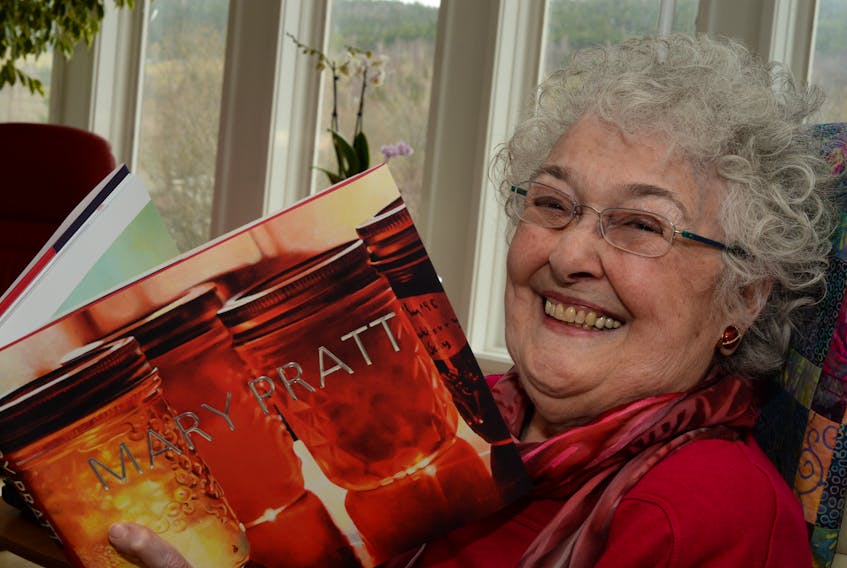Acclaimed artist and arts advocate Mary Pratt has died.
Surrounded by her family at her home in St. John’s, Pratt was 83 when she died on Tuesday.
Born Mary Frances West in Fredericton, N.B., on March 15, 1935, Pratt would go on to be made a Companion of the Order of Canada and the first female Atlantic Canadian artist to have a solo show at the National Gallery of Canada.
Pratt was “the most important female artist in her country,” said gallery owner Emma Butler, who represented Pratt and exhibited her art at the Emma Butler Gallery in St. John’s.
She was awarded nine honorary doctorates, received numerous awards, had countless exhibitions and sat on many boards throughout her accomplished life, but above all she’s remembered for making the ordinary extraordinary.
“A bowl of fruit. A jar of jelly. Fish on a plate. All of a sudden, she gave them an importance,” said Butler. “She has taught us to see the beauty in front of us.”
“We’ve lost her, but we’ve gained her legacy – which is how to look at ordinary things and see how special they are.”
‘My fate was sealed’
From a young age, Pratt noticed the beauty of light on ordinary things.
In an interview with The Telegram in 2001, she recalled waking up one morning as a child to see sunlight hitting a red sweater – it was laid on a chair for her to wear to school.
The sight so moved her, she decided to leave the sweater and wear something else. When she returned home, she said she felt betrayed to find the sweater folded and put away.
“By the time I was 11, my fate was sealed,” she told Telegram reporter Glen Whiffen, as she recalled her childhood when she would often sit on her father’s lap while they drew “stick figures and little boats” to illustrate stories being told.
Indeed, in 1961, she completed a fine arts degree at Mount Allison University.
But throughout the course of her degree, her studies were interrupted as her family began to grow.
She called her decision to follow her then-husband, artist Christopher Pratt, to Newfoundland in 1957 an act of rebellion.
“To leave home and say, ‘I’m going to Newfoundland,’ in those days was pretty major,” she said.
The family moved about during their early years of marriage and eventually settled in Newfoundland, but her children said she never forgot her home.
“Her connection to the St. John River, the wise, plain-spoken words of her father, and the infectious warmth and grace of her mother were with her always,” wrote her children, John, Anne, Barbara, and Ned Pratt, in a statement about their mother’s passing.
“I never left Fredericton,” Mary Pratt told The Telegram’s Tara Bradbury in 2012, explaining how she was still inspired by her home so many years later.
“My mind is still with the crystal and the china and all those things. That will not change, because I decided when I came to Newfoundland that I will never paint Newfoundland. I didn’t think Newfoundlanders needed anybody to show them Newfoundland, so I decided my love was my home, which was New Brunswick.”
Yet in painting the everyday life around her, Pratt gained a reputation for her ability to capture the essence of life in this province.
Newfoundlanders “see her as ours,” said Butler, “but she belongs to the whole country.”
In 1975, Pratt was part of a show at the National Art Gallery in Ottawa and a successful international career soon followed.
Butler said visitors to her gallery “can easily recognize a Mary Pratt.”
“She didn’t imitate any other artist, she had her own style, her own imagery, and people now, you mention Mary Pratt, and people can tell you immediately the image of hers that they remember.”
Pratt’s work ‘changes your experience of daily life’
That image for art curator Mireille Eagan is “This is Donna.”
“It’s burned in my memory,” said Eagan, of the first painting she saw when she entered an art gallery at age 16.
“This figure of a strong woman standing in the art gallery – it was the first encounter that I had with an artwork that really struck me, and that’s the thing I really love about Mary’s work. Her work is the kind of artwork that really stays with you, it changes how you move through the world, it changes your experience of daily life outside the art gallery. For me, I saw that strong woman and I was like, ‘This is what I want to be – this is who I want to be.’”
Eagan curated some of Pratt’s more recent exhibitions, including her solo exhibition at the National Gallery of Canada in 2015.
“She shares things that struck her, things that made her happy, things that made her sad – the loss of children – but also the mundane tasks of making a meal, and in doing that she shows us ourselves.”
‘She was resilient’
In 2001, Pratt told The Telegram her personal motto was “seize the day.”
She lived by that motto despite a range of hurdles.
At university, her professor Lawren P. Harris – son of the Group of Seven’s Lawren Harris – told her that there could only be one painter in a family of painters, and it would have to be her husband, Christopher.
She wasn’t accepted into Glasgow School of Art because she was pregnant.
“Although she constantly maintained this love of painting – it was what drove her – it was often quite difficult for her to make that career,” said Eagan.
Pratt also faced many personal struggles.
In the mid-1970s, she lost twins at birth.
In the 1990s, she and her husband Christopher separated and eventually divorced in 2005.
Through it all, she remained a strong voice for the many causes she generously contributed to.
Pratt was especially instrumental in establishing The Rooms.
“She got the politicians to listen to her,” recalled Butler. “She wouldn’t take no for an answer.”
“In all things she was resilient,” wrote her children.
And through her struggles and successes, she was always an artist.
“What remains are the gifts that she gave us – the hundreds of paintings, twisting back and forth from the projector to the canvas – it damaged her body, she breathed in the dust from the pastel crayons for the work that she made,” said Eagan.
“She said that she wasn’t able to go out much and often felt like she was isolated, and yet the quote from her is, ‘Without that, there wouldn’t have been the paintings’, so what remains are the many gifts that she gave us, and what we have lost is a very beautiful force.”
Twitter: @juanitamercer_
Earlier story:
Acclaimed Canadian and Newfoundland-based artist Mary Pratt died on Tuesday at age 83.
A statement from her family says Pratt died peacefully at her home in St. John’s surrounded by her family.
Loved and celebrated for her artistic genius and community service, Mary Pratt is described by her family as mother, friend, sometimes mentor and counsellor, and a loving grandmother “Nana” to children and grandchildren.
“Our mother was generous with all things, and to everyone,” the statement by children John, Anne, Barbara and Ned Pratt.
“Whether it was her time, her enthusiasm, her talent, or a bundle of cash, she always gave more than was asked or expected to us, her friends, other artists and complete strangers. Her famous smile and infectious laugh were part of every conversation. She had a rich and intelligent sense of humour that lifted everyone around her and lasted throughout her entire lifetime.”
Pratt arrived in Newfoundland in 1957, a Fredericton, N.B. girl from a Wesleyan Methodist background, newly married to Christopher Pratt.
“Although she remained in Newfoundland for the balance of her life, her connection to the St. John River, the wise, plain-spoken words of her father, and the infectious warmth and grace of her mother were with her always,” the statement reads. “She loved and supported her Alma Mater, Mount Allison University, where she studied fine arts and where she first met our father.”
Of her many awards, achievements, and honours Pratt was particularly proud to have been made a Companion of the Order of Canada, and of her role in establishing The Rooms in St. John’s.
“Her art reflected the world around her. She was renowned as a master of light and colour,” the statement read. “She painted what she saw, as she so often explained, and what she saw were not mere surfaces, but images with meaning that ran fathoms deep. As with her images, there was much beneath the surface that we knew and treasured. We will miss her every day.”









